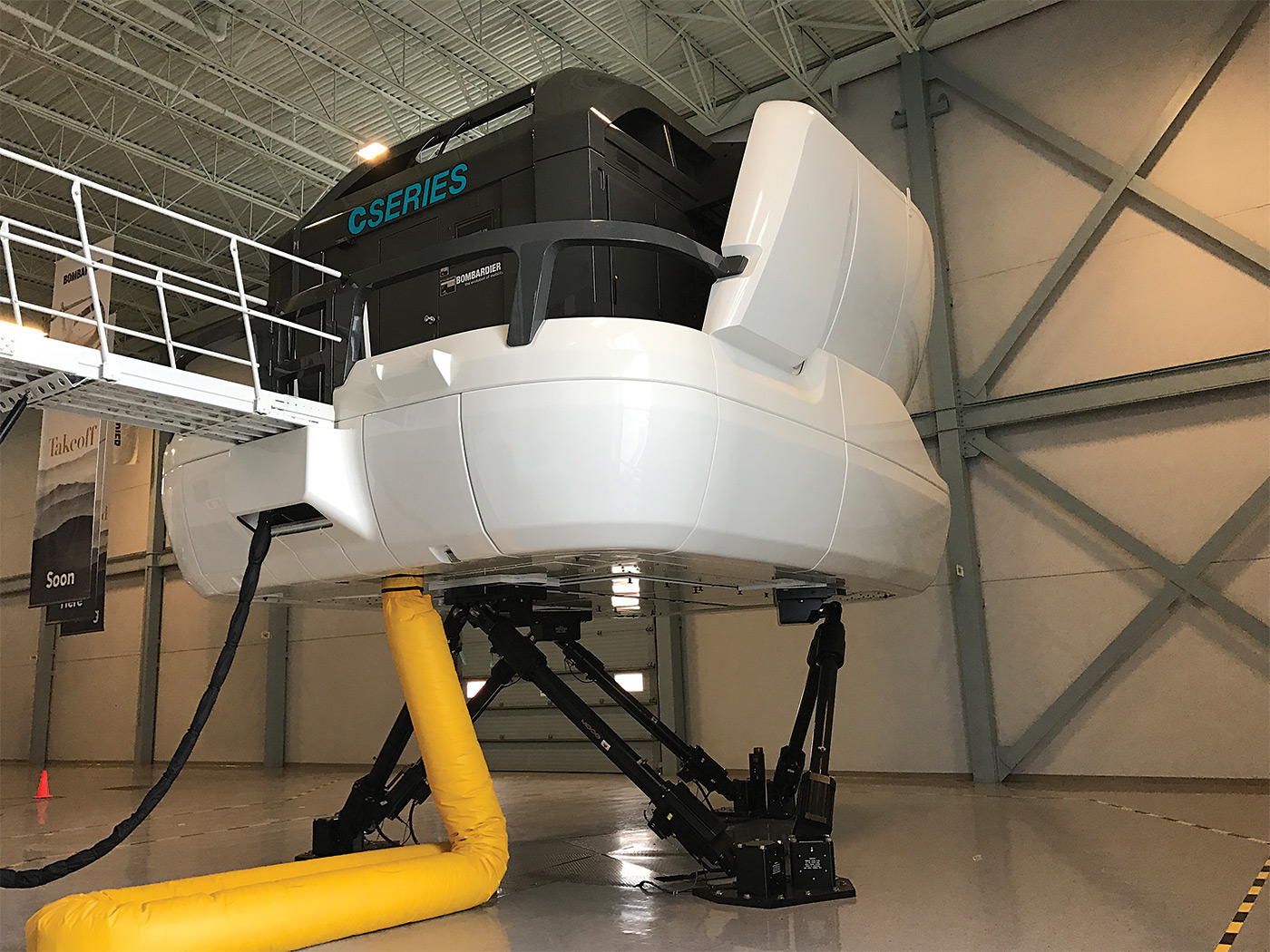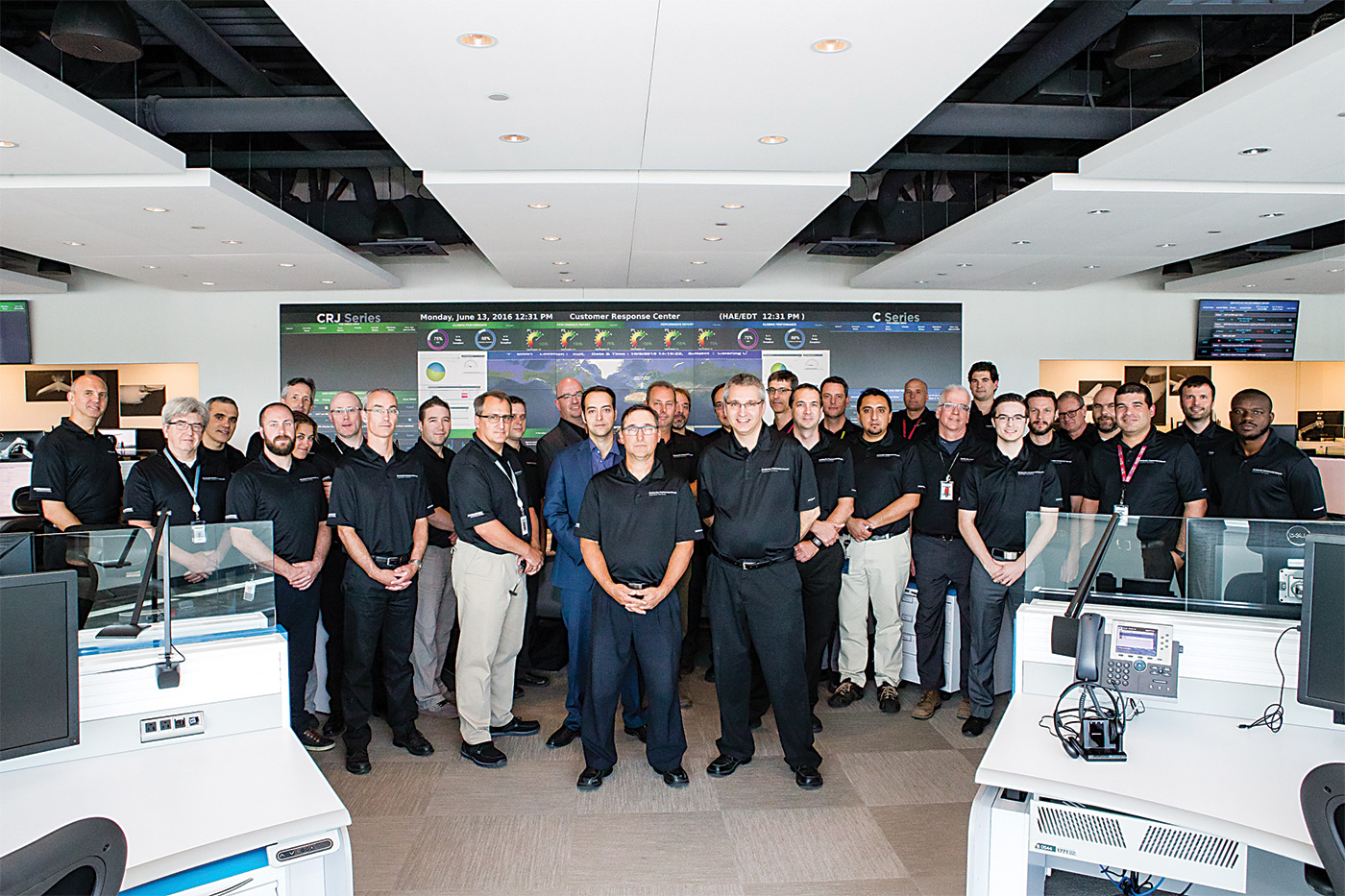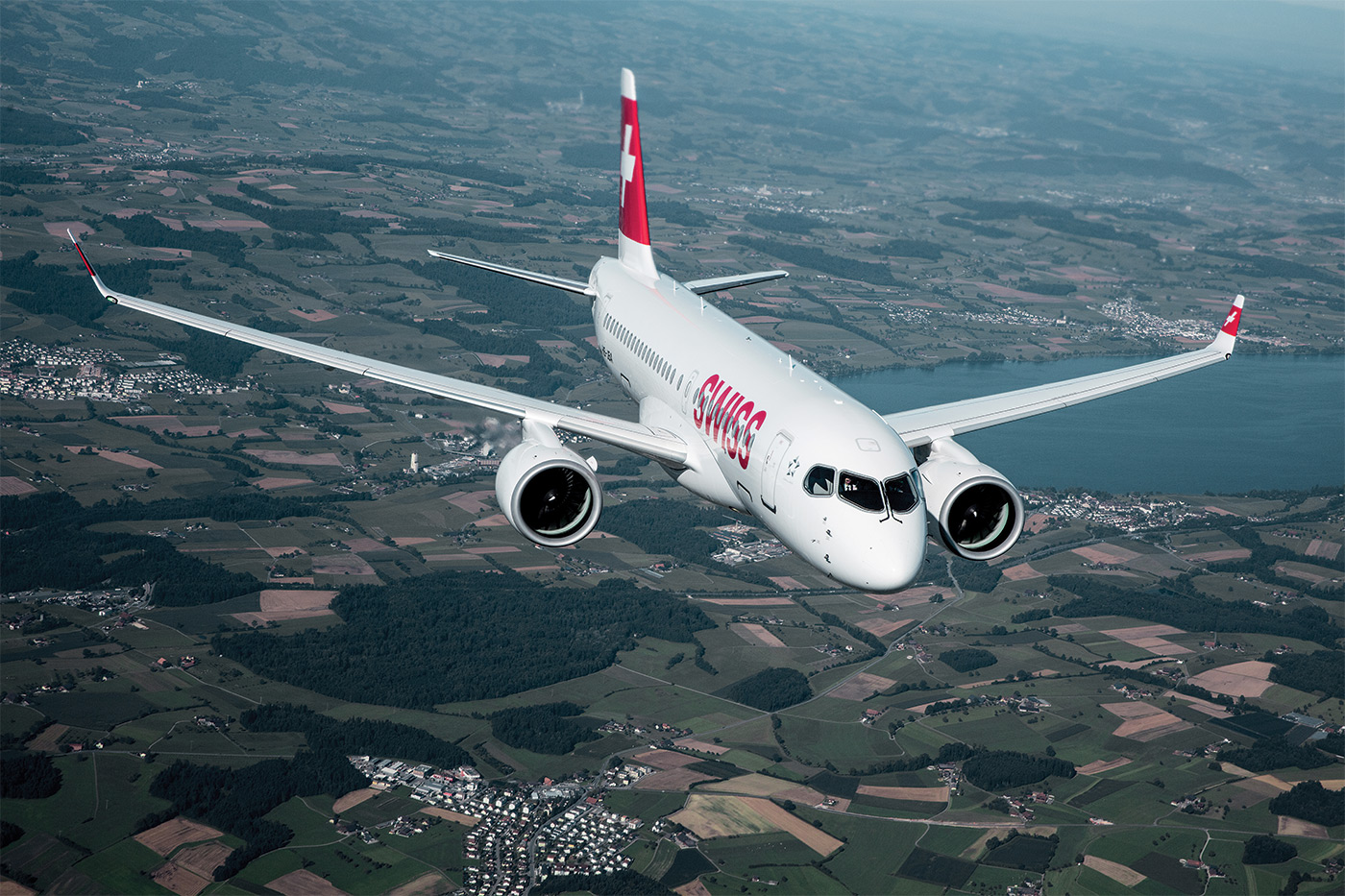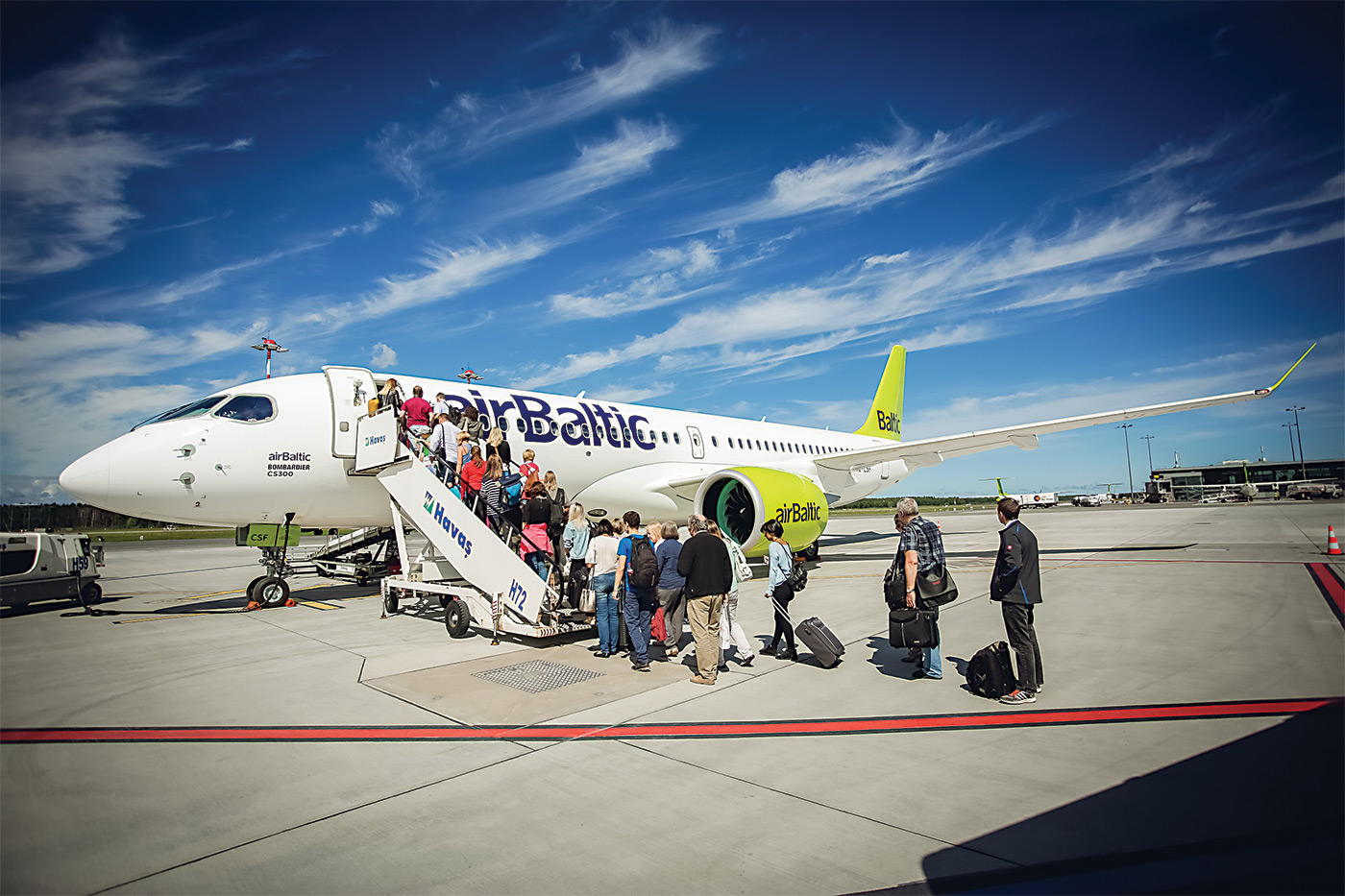Estimated reading time 15 minutes, 2 seconds.
The success of any commercial aircraft ultimately comes down to its ability to make money for an airline.

The more money a new aircraft makes (or saves) the greater its value, especially if it is easy to maintain and consistently delivers its fare-paying passengers to their destinations on time.
Developing a new clean sheet aircraft design powered by an entirely new turbofan family is an expensive and risky venture, which is why it doesn’t occur
very often.
“Having Swiss [International Air Lines] as a launch customer really forced Bombardier to step up its game,” observed a senior Bombardier executive who asked not to be named. “They told us what they wanted and expected when the C Series entered revenue service.”
RISE OF THE C SERIES
Many eyes have followed the Bombardier C Series aircraft program since the brand new design was launched at the Farnborough Air Show in 2008 and the first 100-to-135-seat CS100 (FTV1) flew on Sept. 16, 2013, powered by a pair of Pratt & Whitney PurePower PW1500G geared turbofan (GTF) engines.
While few passengers or aviation enthusiasts in Canada (outside the Greater Montreal Area) have flown in or seen a C Series jet, more than two million European passengers have flown on the aircraft from the first revenue passenger flight with Swiss in mid-July 2016 to the end of 2017.
In the first year of service, the C Series fleet served more than 100 routes, completed over 160,000 revenue flights (up to 100 revenue flights per day), and flew up to 10 legs and 17 flight hours per day, per aircraft. Turnaround times were as short as 35 minutes.
By the end of 2017, Bombardier had delivered 24 C Series from its Mirabel Airport factory, including seven aircraft in 2016 (five CS100s and two CS300s) and 17 in 2017 (three CS100s and 14 CS300s).
On New Year’s Day, Swiss was flying 15 C Series (eight CS100s and seven CS300s); airBaltic was operating seven CS300s; and Korean Air Lines was scheduled to launch domestic flights from Seoul on Jan. 16, 2018, with two CS300 aircraft delivered at the end of December.
Bombardier missed its original target of more than 30 deliveries in 2017 (initially because of Pratt & Whitney engine delays), but it is scheduled to deliver at least 40 new jets in 2018.
DESIGNING A SERVICE-READY AIRCRAFT
Bombardier started preparing for the C Series aircraft’s entry into service at the very beginning of the aircraft development program, said Todd Young, vice-president and general manager, Customer Services and Q400 Aircraft Program, Bombardier Commercial Aircraft.

“Our customer service organization has been working on the C Series program since the very beginning,” he explained. “We embedded customer service representatives into the Integrated Product Development Teams (IPDT)… [to bring] in-service experience to the design of the aircraft, with a total focus around improving the overall maintainability of the aircraft, the reliability of the aircraft, and the overall management of the aircraft in service.”
During the C Series design process, “We had input on where the maintenance access points were on the aircraft, the location of equipment on the aircraft, and the actual design layout from a maintainability and cost point of view,” added Young.
LAUNCH CUSTOMERS
When Bombardier launched the C Series program in July 2008, oil prices had reached a record US$147 a barrel.
Pratt & Whitney’s ultra-high-efficiency geared turbofan engine was a real differentiator for the C Series. The powerplant’s state-of-the-art gear system allows the engine’s fan to operate at a different speed than the low-pressure compressor and turbine, thereby delivering double-digit reductions in fuel burn, CO2 and NOX emissions, engine noise and operating costs. This meant airlines would spend less on fuel and fly a “greener” aircraft.
In March 2009, Bombardier announced that Deutsche Lufthansa AG, the launch customer for the C Series, had signed a firm purchase agreement for 30 CS100 aircraft to be operated by its subsidiary, Swiss, with the aircraft originally expected to enter service in 2013.
The first Swiss CS100 aircraft would replace a fleet of four-engine BAE/Avro RJ100s that were expensive to operate and aging.
Then airBaltic, the national airline of Latvia, became the launch customer for the larger CS300 when it placed an order for 10 aircraft, in December 2012, with 10 options that were later converted into firm orders.

The CS300s were ordered to complement a mixed fleet of classic Boeing
737-300s and 737-500s and 12 Bombardier Q400 turboprops flying with the Riga-based airline.
At the 2015 Paris Air Show, Swiss announced it was converting 10 of its 30 firm-ordered CS100 aircraft to the larger CS300 aircraft.
With today’s lower fuel prices, the operating cost advantages of the more fuel-efficient C Series aren’t as great as they were when it launched in 2008, but the two European launch customers are still very pleased with the passenger experience and operating economics, according to written statements from both airlines to Skies.
Both provide good examples of airlines selecting the C Series to “right size” their routes and fleets to improve profit per passenger.
REDEFINING CUSTOMER SERVICE
As the C Series advanced through the development and flight test program, Todd Young said the Bombardier customer service team focused on three key initiatives.
“First, we started to look at our [customer service] systems and tools in use for our existing platforms,” said Young.
The primary focus was on developing new “e-tools” or electronic systems that would complement the sophisticated health management system (HMS) installed on every C Series aircraft.
(The HMS, now known as the FlightLink system, is connected to the aircraft avionics and collects data from all the various electronic sensors throughout the aircraft, relaying it to the ground, together with P&W PW1500 engine data.)
One of the most important new e-tools was the Bombardier Electronic Fault Isolation Manual (EFIM).
“This is an electronic system that the airline uses to troubleshoot the aircraft. It is also used to return the aircraft to service,” said Young. “In the past, we had a troubleshooting system that was separate from the fault isolation manual. Now we have integrated the troubleshooting tool with the fault isolation manual into a single electronic system.”
Next, Bombardier developed a new customer web portal at www.iflybombardier.com to better connect with its customers.
“This is the access point to a complete repository of all the technical publications, in-service engineering reports and supplier information that an airline needs to manage the aircraft,” said Young.
Another addition introduced a new customer relationship management (CRM) tool, powered by Salesforce. The integrated system helps accelerate the support Bombardier provides its customers and also allows a customer to trace how Bombardier’s response to a question or inquiry is progressing.
Bombardier’s second major customer service initiative was to build “a brand new Customer Response Centre (CRC) at our Mirabel factory that is central and staffed 24 hours a day, seven days a week, 365 days a year,” said Young.
When Skies toured the state-of-the-art facility in September, the strongest feature was a large illuminated wall containing key C Series fleet metrics, including a map showing the location of every new generation jet throughout its flying day.
“The team includes engineering specialists covering all the systems and structure on the aircraft, surrounded by individuals in support groups that include technical publications, spare parts, flight operations and suppliers,” said Young.
START-UP TEAMS
Bombardier’s third important customer service initiative saw the OEM place a much larger team of technical experts on the ground to support the new jet’s entry into service.

“[When] we looked back to see how we managed the entry into service of our previous aircraft, it became apparent that we needed to step up our support for the launch of C Series service,” said Young.
“Then we actually did a pilot project of our new approach using the delivery of new Q400 turboprops to WestJet to test our new concept. We learned a lot from this exercise and how to further improve the process.
“The start-up teams deployed to Swiss and airBaltic, and they are now on the ground in Korea, including liaison pilots, in-service engineers, field service representatives, maintenance engineers, technical publications and spares specialists as well as field service reps from all of the C Series aircraft’s key suppliers,” said Young.
Every C Series start-up team includes an on-site manager responsible for overseeing the entire entry-into-service group, a lesson learned from the WestJet trial.
The primary role of the team is to ensure “knowledge transfer” regarding the aircraft to the airline’s key personnel, as well as to assist with any kind of disruption in the early days of passenger service.
Swiss and airBaltic also contracted for additional Bombardier technical support when they joined the C Series Smart Parts program, which provides the airlines with comprehensive component maintenance, repair and overhaul (MRO) services, access to a strategically located spare parts exchange pool, and an on-site inventory at their respective operating hubs.
Bombardier has also been working closely with Pratt & Whitney to resolve issues with its geared turbofan engines to make them more durable.
SWISS IMPRESSIONS
Swiss inaugurated Bombardier CS100 revenue service on July 15, 2016, between Zurich and Paris Charles de Gaulle Airport, with the aircraft in a 125-seat configuration.

“Compared with other totally new aircraft types, the entry into service of the C Series went very smooth,” wrote a Swiss representative in an emailed response to questions from Skies.
“We only had minor issues; for example, with the air conditioning or deicing or with the cabin management system. In close collaboration with Bombardier, we were able to address most of these issues by now. All in all, we are satisfied with the performance of the C Series.”
On May 26, 2017, Swiss took delivery of its first 145-seat CS300 aircraft featuring 30 seats in business class and 115 seats in the main cabin.
“With its size and its lower unit costs, the CS300 is the ideal complement to the CS100 and the rest of our European fleet,” continued the Swiss spokesperson. “So with these two new aircraft types, we can align our capacity very closely to demand, providing more flexibility on all our European routes.”
The majority of the Swiss CS100 order was used to replace the aging Avro RJ100s, with the CS300 aircraft partly used to replace Airbus A319s and A320s out of Geneva, as well as to enable moderate future growth.
The introduction of the CS100 helped Swiss reduce its operating costs by 25 per cent, per seat, in comparison with the Avro RJ100, through lower maintenance costs and more fuel efficient engines.
“We are pleased to report that certain performance parameters, such as fuel consumption and range, have proven substantially better than agreed. The fuel consumption is 20 to 25 per cent lower compared with the Avro RJ100. It is also 10 to 15 decibels quieter than comparable aircraft types, which is very important for densely populated areas,” reported Swiss.
The airline told Skies it did not adapt its network or introduce new routes when the C Series entered service.
“The CS300 aircraft offers 20 additional seats at only slightly higher production costs. This is an important factor concerning our profitability, especially also from our base in Geneva.”
The airline also said its pilots praise the C Series and are particularly impressed with its intuitive flight crew interface.
The first pilots, cabin crew and technicians were trained at Bombardier training facilities, but now all Swiss pilots are trained at Lufthansa Aviation Training in Switzerland.
AIRBALTIC EXPERIENCE
On Dec. 14, 2016, CS300 launch operator airBaltic completed its first commercial flight between Riga and Amsterdam with 120 passengers on board.

“The aircraft has performed beyond the company’s expectations, delivering better overall performance, fuel efficiency and convenience for both staff and the passengers,” airBaltic told Skies.
“[The] CS300 is a state-of-the-art aircraft that offers an excellent flying experience, with benefits for passengers such as wider seats, larger windows, more hand luggage space, and improved lavatories, among others.
“With the introduction of brand new Bombardier CS300 aircraft, this year airBaltic has increased the number of passengers served by 21 per cent. Thanks to the improved efficiency of the aircraft, this summer was the strongest in the history of airBaltic. For several months in a row, airBaltic, which turned 22 this autumn, reached record high passenger flows as well as revenue,” concluded the airline.
As of early December 2017, airBaltic–which boasts a 90.01 per cent on-time performance, making it the world’s most punctual airline according to travel analyst OAG–had carried more than 630,000 passengers on the Bombardier CS300 aircraft. In total, the airline said the new aircraft have performed in excess of 6,023 commercial flights and flown more than 16,000 block hours, with every fourth passenger now flying on the CS300.
The first CS300 deliveries to airBaltic supported a growth strategy.
In 2017, airBaltic launched 13 new destinations from its main hub in Riga and will add at least seven more in 2018.
The airline said the C Series has 30 per cent longer range than the classic Boeing 737s (737-300 and 737-500) it currently flies. This has allowed it to identify at least 11 long distance routes into Europe, North Africa, the Middle East and the former Soviet Union for future service.
Notably, in late October, airBaltic launched non-stop passenger service between Riga and Abu Dhabi with the CS300, reporting strong traffic on the six-hour, 2,359-nautical mile (4,369-kilometre) route.
The airline’s fleet modernization plan calls for an additional 11 CS300 aircraft. AirBaltic would also like to replace its 12 Q400 turboprops with CS100s in order to operate an all-C Series fleet by 2020. However, as of early 2018, it had not yet ordered any CS100s.

The commonality benefits of an all-C Series fleet include a uniform passenger experience, pilot interchangeability, and one set of spares and equipment for reduced capital expenditures and overhead.
In terms of fuel efficiency, airBaltic reported that the CS300s burns an average of 20 per cent less fuel than the 737-300 it has replaced. For example, between Riga and London, the aircraft burns 22 per cent less fuel. (Fuel currently accounts for 20 per cent of the airline’s operating expenses.)
Upgrading from the 77-seat Q400 to the 145-seat CS300 on the Riga-Brussels route, for example, would cut flight times by 31 minutes, almost double the sellable seats, and reduce the operating cost per seat by 57 per cent, allowing airBaltic to offer lower fares.
As for the passenger perspective, the airline said they “love the enhanced comfort of the C Series,” noting that the aircraft offers the quietest cabin in its class, the largest overhead luggage space in its class, the greatest seat width and the widest middle seat of any single-aisle aircraft. As well, the windows are 26 per cent bigger than the 737 and provide more natural light.
The first airBaltic crews trained in Canada. Today, technician training is done in Riga and the pilots train on a CAE simulator in Frankfurt.
PROVING ITS WORTH
Developing a new clean sheet commercial aircraft is not for the faint of heart.
It is often regarded as an aggressive “bet the company” product strategy that aims to be first-to-market with a new generation aircraft offering significant operating cost savings together with enhanced performance capabilities.
Bombardier first looked at a new 90- to 130-seat aircraft in the late 1990s but backed away, providing an opportunity for Embraer to enter the market.
The development of the Pratt & Whitney PW1500 geared turbofan engine provided the Canadian OEM with a new opportunity to enter the 100- to 150-seat market with a new aircraft offering significantly lower operating costs, fuel burn emissions and noise.
The C Series design targets were met or exceeded, and all that remains now is for the jet to continue proving its worth and reliability in the field.
